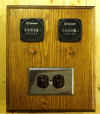
Build your own Time Clock
Let's face it, you spend lots of time on your shop. If you run your woodshop for revenue like we do, you want to make sure you have a good understanding of exactly how much time you put into making projects to analyze how long projects will take, or to bill out shop time for client reimbursement.
What can you do?
You can go out and buy a real time clock, like the kind workers would use to clock in and out, but those are expensive, and you would have to buy and use time cards, and add up the hours when a project is done -- a big hassle all around.
Our solution is to buy an 'hour meter' -- a neat little machine that counts off hours for as long as it is plugged in, and build it into your own shop 'time clock'.
The Hour Meter Time Clock; Click on picture to see larger image
In our case, two hour meters were installed in a box, and when projects were started, the switch to the respective hour meter turned on, allowing the meter to start accumulating the time spent on the project. When work was stopped, the meter was turned off. The result is a simple recording of the time spent on each project. No complicated estimating or counting hours. Instead of an expensive time clock running 24/7, the hour meter only uses electricity when it is turned on.
When a project is finished, the meter is re-set, or set back to zero, so the meter is ready for the next project. Note that having multiple meters is a must when multiple projects stop and start. While two hour meters may suffice in a small shop like ours, larger shops should consider having more meters to keep track of higher volume/output.
Here is what you need to make your own Time Clock:
120 VAC re-settable hour meters; these have a button that re-sets the meter back to zeros. Most hour meters record up to 9,999.00 hours, which should be more than enough time to record even the most difficult projects; but look for meters that have at least 999 hours, so the meter can never ever turn over to zero while your project is still in process.
Box to install the meter and switch box in. This can be metal or wood, as long as you have the tools and ability to machine the box to your needs. Sorry, we don't have a plan for you to follow; a good wood/metal worker should be able to make simple stuff like this from their own imagination and visualization skills!
120 VAC switch, one switch for each meter, in this case, a duplex (2 switches) was used.
120 VAC pilot light, so you can see that the meter is running, and remember to turn the meter on and off when entering and leaving the shop. If the meter runs when you are out of the shop, your time analysis will be worthless, unless you leave the shop on business, foe example, for get more materials and supplies, and you are billing a client for your time.
Good luck!